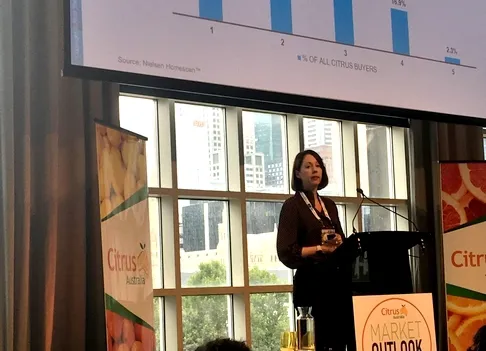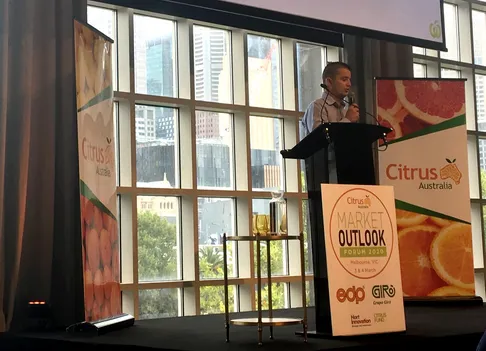Information from one of Australia's leading research companies has found that the national citrus industry could add an additional $149 million a year if customers added just one more type of citrus to their regular shop.
Nielsen Homescan involves a panel of 10,000 households who record their grocery sales for market research purposes. Director of Analytics Chanel Day says "the law of double jeopardy" has found that the more households buying a product, means the more frequently they will also buy your product.
"No matter what category you look at: whether it is milk, canned foods, frozen foods, we've seen this law duplicate over time, across all categories," Ms Day said. "What it means is that the best strategy is to get more households to buy your products, and the more households you have, the more will also buy more frequently - so you get double the impact on sales. We can also see that of all citrus buyers, most commonly, they are only buying two types of citrus. Less than half are buying more than two. We did some calculations to work out if we could get those buying one citrus fruit, to buy two - and those buying two to buy three - it works out to be a $149million opportunity."
Ms Day says the data also show that the supermarkets in Australia are gaining a greater share of the fruit sales market, year on year.
"Where is that share coming from the smaller independent operators; greengrocers and markets," she said. "So, in early 2018, they represented 18.5 per cent of total fruit sales, but that has now declined to just 16.5 per cent. Citrus is a little different where greengrocers and markets now have around 18.6 per cent. That is still a significant amount of sales, so any marketing strategies that we develop, really need to consider this channel. It is really important to be reaching as many buyers as possible, as instantly as possible. It is probably more important for citrus than other fruits that have sales more dominated by the supermarkets."

Another area for growth, identified by Nielsen Homescan is online, which Ms Day says is the fastest-growing channel in Australia, with sales growing seven times the rate of total grocery sales.
"However, sales of fresh fruit online are still very small," she said. "By far and away, the majority of fresh fruit is still sold in bricks and mortar stores. There is certainly growth; three years ago, only 2.4 per cent of all fruit sales were sold online, that's jumped to 3.4 per cent today, and that is continuing to grow quickly. What is interesting is not just how fast online is growing, but who are the consumers shopping online. We know that families only account for 36 per cent of fruit sales overall; back in 2018 they accounted for 50 per cent of online sales, now they account for 61 per cent of fruit sales online. We don't have to think too hard to connect the dots. We know that the citrus industry under indexes in selling to families, we know that online is a fast-growing channel and we know that online is where you can sell to families. So digital strategies that sell to families will go a long way to giving the industry a boost."
Ms Day also noted the changing demographic profiles in Australia in the past 30 years, due to immigration, and that producers need to keep up with the shift in consumers. She says that the whole industry needs to be planting trees today, it will also need to factor in who is going to buy the fruit in the long-term future, as multicultural trends will impact on demand in the future.
Woolworths Category manager for citrus and tropical fruit, Dan Scott, says the understanding of citrus customers have evolved from a hypothetical person fitting a simplistic customer, to realising it was a more complex issue.
"One in four Australians were born overseas, two out of three live in a city, two in three don't even own a car, and 11.2 per cent identify as a vegetarian," he said. "In addition, 2.5 per cent shop online for groceries, and that figure is increasing significantly. What this means is that we need to service all of these people. We cannot simply throw them into the budget, mainstream, or premium categories. We need to understand who the what all of them want, and tailor to those needs."
Mr Scott added that Woolworths research uncovered that the most common occasion for the consumption of a citrus product is a snack between meals, rather than as part of a main meal.
"Of the main meals, breakfast is the most common occasion," he said. "What came as most of a surprise for me, is that with breakfast the most common occasion, the most commonly bought item was actually oranges. Over the last couple of seasons, we've generally seen a steady decline in penetration and consumption of oranges. So, there may be an opportunity to capture or tap into the breakfast orange category."

The research went further, to outline common trends in both the mandarin and orange categories.
"Orange customers are a mix of older families and younger families, and older singles and couples," Mr Scott said. "But one thing that I haven't figured out is that the largest basket affinity for oranges is nuts. There has been a decline in oranges in the past few years, and we are losing customers to mandarins, melons and grapes. Over recent times we have done a few trials putting larger fruit sizes in particular stores. What we have found is that customers will return to the category, as they are after value, and that can come from a larger piece of fruit. Who is the mandarin customer? They are also older families and younger families, and older singles and couples. They are telling us that are wanting seedless and easy-peel for convenience; those customers are shopping for things like children’s' lunchboxes, and want to eat as snacks. Positively, mandarins are gaining customers from oranges, apples and watermelon."
Mr Scott explains that lemons and limes are more occasion-based purchasing, and are not price sensitive. While Woolworths is experiencing strong growth in limes, he says that it is not as simple as pulling the price lever to attract customers, so other ways are needed across the industry to inspire consumers to buy and use limes more frequently throughout the year.
But overall, he said one of the main drivers for citrus consumption for the supermarket giant is quality.
"I am really passionate about the quality aspect," Mr Scott said. "Our customers often tell us that they are after a value offer from a citrus perspective, and they want quality every time that they come in. They want a quality eating experience and it's not all about price. We need to be competitive, and have promotional frequency - but most of all, customers are telling us they want consistency from a quality perspective. They are also telling us health is also important, so it is important we can deliver it to them."
For more retail trends across all fruit and vegetable categories, visit: Harvest to Home
